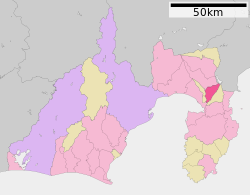Mishima, Shizuoka
|
Mishima 三島市 |
|||
|---|---|---|---|
| City | |||

downtown Mishima
|
|||
|
|||
 Location of Mishima in Shizuoka Prefecture |
|||
| Coordinates: 35°07′6.6″N 138°55′6.8″E / 35.118500°N 138.918556°ECoordinates: 35°07′6.6″N 138°55′6.8″E / 35.118500°N 138.918556°E | |||
| Country | Japan | ||
| Region | Chūbu (Tōkai) | ||
| Prefecture | Shizuoka Prefecture | ||
| Government | |||
| • Mayor | Takeshi Toyooka (since December 2010) | ||
| Area | |||
| • Total | 62.02 km2 (23.95 sq mi) | ||
| Population (December 2016) | |||
| • Total | 109,872 | ||
| • Density | 1,772/km2 (4,590/sq mi) | ||
| Time zone | Japan Standard Time (UTC+9) | ||
| City symbols | |||
| • Tree | Ginkgo biloba | ||
| • Flower | Mishima sakura | ||
| • Bird | European kingfisher | ||
| Phone number | 055-975-3111 | ||
| Address | 4-47 Kitatamachi, Mishima-shi, Shizuoka-ken 411-8666 | ||
| Website | www |
||
Mishima (三島市 Mishima-shi?) is a city located in eastern Shizuoka Prefecture, Japan.
The city, which covers an area of 62.02 square kilometres (23.95 sq mi), had an estimated population in December 2016 of 109,872, giving a population density of 1,772 persons per km2.
Mishima is located in far eastern Shizuoka Prefecture, at the northern end of Izu Peninsula and in the foothills of Mount Fuji.
Mishima has a humid continental climate (Köppen climate classification Cfa) with hot summers and cool winters. Precipitation is significant throughout the year, but is heaviest from June to September.
Mishima is an ancient town, which developed around the important Shinto shrine of Mishima Shrine (三嶋大社 Mishima Taisha?). Under the Ritsuryo administration system established in the Nara period, Mishima was made capital of Izu Province. It was also the location of the Kokubun-ji for Izu Province. In the Edo period, Mishima prospered from its location on the Tōkaidō highway connecting Edo with Kyoto, and Mishima-shuku was one of the 53 post stations on that road. The area was tenryō territory ruled by a daikan appointed directly by the Tokugawa shogunate. After the Meiji Restoration, Mishima became part of the short-lived Nirayama Prefecture in 1868. This merged with the equally short-lived Ashigara Prefecture in 1871, and became part of Shizuoka Prefecture from April 18, 1876. During the cadastral reform of 1889, the area was reorganized as Mishimi Town within Kimisawa District. In 1892, Prince Komatsu Akihito established a villa in Mishima. Its gardens, the Rakujūen, are a noted visitor attraction in Mishima to this day. In 1896, Kimisawa District became part of Tagata District, Shizuoka. Mishima received its first train connection in 1898 when the predecessor of the Izuhakone Railway established what is now Shimo-Togari Station. The Sunzu Line began operations from 1906. However, Mishima's fortunes revived strongly only after the Tanna Tunnel was completed in 1934, connecting the town to the Tōkaidō Main Line railway between Tokyo and Shizuoka. Mishima developed rapidly afterwards, merging with neighboring Kitakami Village in 1935 and Watada Village in 1941. Mishima Town was elevated in status to a city on April 29, 1941. It became a stop on the Tōkaidō Shinkansen from 1969, leading to an expansion in population, as the line made it possible to commute to Tokyo.
...
Wikipedia



